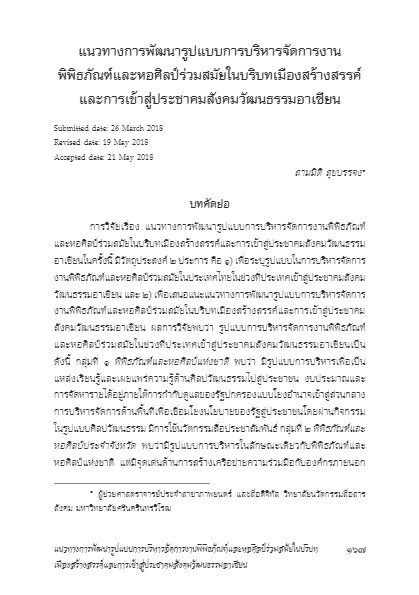สามมิติ สุขบรรจง
บทคัดย่อ
การวิจัยเรื่อง แนวทางการพัฒนารูปแบบการบริหารจัดการงานพิพิธภัณฑ์และหอศิลป์ร่วมสมัยในบริบทเมืองสร้างสรรค์และการเข้าสู่ประชาคมสังคมวัฒนธรรมอาเซียนในครั้งนี้ มีวัตถุประสงค์ 2 ประการ คือ 1) เพื่อระบุรูปแบบในการบริหารจัดการงานพิพิธภัณฑ์และหอศิลป์ร่วมสมัยในประเทศไทยในช่วงที่ประเทศเข้าสู่ประชาคมสังคมวัฒนธรรมอาเซียน และ 2) เพื่อเสนอแนะแนวทางการพัฒนารูปแบบการบริหารจัดการงานพิพิธภัณฑ์และหอศิลป์ร่วมสมัยในบริบทเมืองสร้างสรรค์และการเข้าสู่ประชาคมสังคมวัฒนธรรมอาเซียน ผลการวิจัยพบว่า รูปแบบการบริหารจัดการงานพิพิธภัณฑ์และหอศิลป์ร่วมสมัยในในช่วงที่ประเทศเข้าสู่ประชาคมสังคมวัฒนธรรมอาเซียนเป็นดังนี้ กลุ่มที่ 1 พิพิธภัณฑ์และหอศิลป์แห่งชาติ พบว่า มีรูปแบบการบริหารเพื่อเป็นแหล่งเรียนรู้และเผยแพร่ความรู้ด้านศิลปวัฒนธรรมไปสู่ประชาชน งบประมาณและการจัดหารายได้อยู่ภายใต้การกำกับดูแลของรัฐ ปกครองแบบโยงอำนาจเข้าสู่ส่วนกลาง การบริหารจัดการด้านพื้นที่เพื่อ เชื่อมโยงนโยบายของรัฐสู่ประชาชนโดยผ่านกิจกรรมในรูปแบบศิลปวัฒนธรรม มีการใช้นวัตกรรมสื่อประชาสัมพันธ์ กลุ่มที่ 2 พิพิธภัณฑ์และหอศิลป์ประจําจังหวัด พบว่ามีรูปแบบการบริหารในลักษณะเดียวกับพิพิธภัณฑ์และหอศิลป์แห่งชาติ แต่มีจุดเด่นด้านการสร้างเครือข่ายความร่วมมือกับองค์กรภายนอกในจังหวัดและข้ามจังหวัด มีการใช้สื่อท้องถิ่น และมีการพัฒนาสื่อประชาสัมพันธ์ รวมทั้งเน้นการจัดกิจกรรมที่เชื่อมโยงกับนโยบายของจังหวัด กลุ่มที่ 3 พิพิธภัณฑ์และหอศิลป์ในมหาวิทยาลัย พบว่ามีรูปแบบการบริหารที่รับนโยบายจากส่วนกลาง แต่มีลักษณะเด่นคือการสร้างเครือข่ายความสัมพันธ์ และบริหารจัดการเพื่อให้เป็นแหล่งเรียนรู้ที่สนับสนุนพันธกิจด้านการศึกษา รวมทั้งมีสถานะเป็นที่พึ่งให้กับศิลปิน นักวิชาการ และประชาชน กลุ่มที่ 4 พิพิธภัณฑ์และหอศิลป์เอกชน พบว่าแต่ละพิพิธภัณฑ์และหอศิลป์มีรูปแบบการบริหารจัดการที่หลากหลาย มีความคล่องตัวและยืดหยุ่นสูง บุคลากรมักทำงานได้หลายหน้าที่ มีการสร้างเครือข่ายกับองค์กรภายนอก การบริหารจัดการด้านพื้นที่มีการสร้างจุดเด่นในแต่ละพื้นที่ ผลการวิจัยประเด็นที่ 2 สรุปได้ดังนี้ แนวทางการพัฒนารูปแบบการบริหารจัดการงานพิพิธภัณฑ์และหอศิลป์ร่วมสมัยในบริบทเมืองสร้างสรรค์และการเข้าสู่ประชาคมสังคมวัฒนธรรมอาเซียนเป็นดังนี้ กลุ่มที่ 1 พิพิธภัณฑ์และหอศิลป์แห่งชาติ พบว่า มีการนำนโยบายฯ มาปรับใช้ในการกำหนดแนวทางการบริหารจัดการ กลุ่มที่ 2 พิพิธภัณฑ์และหอศิลป์ประจําจังหวัด พบว่ามีการนำนโยบายฯ มาปรับใช้ในการกำหนดแนวทางการบริหารจัดการ และมีการวางแผนให้ความรู้และสร้างความเข้าใจเรื่องอาเซียนในระดับบุคลากร แต่ยังไม่ปรากฏแผนการบริหารจัดการเพื่อให้เกิดความต่อเนื่อง กลุ่มที่ 3 พิพิธภัณฑ์และหอศิลป์ในมหาวิทยาลัย พบว่ามีการนำนโยบายฯ มาปรับใช้ในการกำหนดแนวทางการบริหารจัดการ แต่การให้ความสำคัญจะขึ้นอยู่กับผู้บริหารของแต่ละองค์กร กลุ่มที่ 4 พิพิธภัณฑ์และหอศิลป์เอกชน พบว่าส่วนใหญ่มิได้ให้ความสำคัญกับนโยบายฯ ว่าเป็นเรื่องเร่งด่วน เนื่องจากได้ดำเนินการเรื่องดังกล่าวมาก่อนหน้าที่รัฐบาลจะกำหนดนโยบาย และเสนอแนวทางการบริหารจัดการเพื่อให้เกิดความยั่งยืนว่า สิ่งที่จะทำให้ศิลปะของไทยสามารถตามเพื่อนบ้านอย่างอาเซียนทันคือการปรับตัวและการปลูกฝังความคิดเรื่องความคิดสร้างสรรค์ในระบบการศึกษา รวมทั้งการทำความเข้าใจกับวัฒนธรรมที่แตกต่างหลากหลายในภูมิภาคอาเซียนจะทำให้เกิดการแลกเปลี่ยนและทำให้วงการศิลปะร่วมสมัยยังดำรงอยู่ต่อไปได้
คำสำคัญ: พิพิธภัณฑ์, หอศิลป์ร่วมสมัย, การจัดการ, เมืองสร้างสรรค์, อาเซียน
(ตีพิมพ์ใน วารสารไทยศึกษา ปีที่ 15 ฉบับที่ 1 (มกราคม – มิถุนายน 2562) หน้า 167-204)
The Development Model for Museum and Contemporary Arts Gallery Management in the Context of the Creative City and the ASEAN Socio-Cultural Community-ASCC
Sammitt Sukbanjong
Abstract
The development model for museum and contemporary art gallery management in the context of the Creative City and the ASEAN Socio-Cultural Community-ASCC has two purposes. Firstly, to specify the style of management of contemporary museums and galleries in Thailand during the period of entry into the ASEAN Socio-Cultural Community-ASCC. Secondly, to provide guidance on the development of contemporary art museum and gallery management in the context of creative cities and the entry into the ASEAN Socio-Cultural Community-ASCC.
The results of the first objective of this research is to specify the style of management of contemporary museums and galleries in Thailand during the period of entry into the ASEAN Socio-Cultural Community-ASCC. Group 1: National museums and galleries were found to have an administrative model for learning and disseminating cultural knowledge to the people; budget and revenue provisions are subject to state oversight; space management links public policy to the people through cultural and artistic activities; the use of innovative media outlets. Group 2: Provencal museums and galleries were found to have an administrative style similar to that of the group of the national museums and galleries, with a strong network of cooperation with outside organizations in the province and across provinces; local media is used for the media development; the focus of activities is linked to the policy of the province. Group 3: For university museums and galleries, it was found that there is a centralized administration model, however a distinctive feature is the networking of relationships and managed to be a learning resource that supports the educational mission, as well as being a place for artists, academics and the public. Group 4: For private museums and galleries, each museum and gallery exhibits a variety of management styles and flexibility; personnel often perform multiple functions; networking with external organizations and space management has been featured in each area.
The results of the second objective of this research is to provide guidance on the development of contemporary art museum and gallery management in the context of creative cities and the entry into the ASEAN Socio-Cultural Community-ASCC. The results are as follows. Group 1: For national museums and galleries, it was found that they have implemented the policies to their management approach. Group 2: For provincial museums and galleries, it was found that they also have implement the policies to their management approach, which is a plan to educate and understand ASEAN Socio-Cultural Community-ASCC at the personnel level; management plans for continuity has not yet appeared. Group 3: For university museums and galleries, it was found that they have also implement the policies to their management approach; however, the importance depends on the management of each organization. Group 4: For private museums and galleries, it was found that most do not pay attention to the policies; which is an urgent matter because of their concern of these policies before the government has set and promoted the policies; private museums and galleries also propose a management approach for sustainability.
What will make the Thai art world follow the neighboring ASEAN is to adapt and implant ideas of creativity in the education system. Understanding the diversity of cultures in the ASEAN region will lead to exchanges and furtherance of contemporary art.
Keywords: museums, contemporary art galleries, management, Creative City, ASEAN
(Published in Journal of Thai Studies Volume 15 Number 1 (January – June 2019) Page 167-204)
บทความ / Full Text : download
